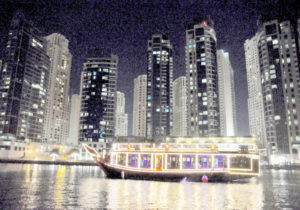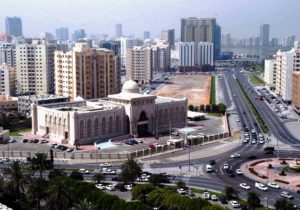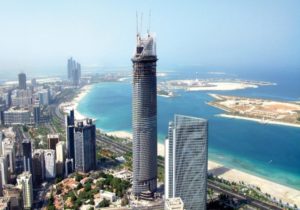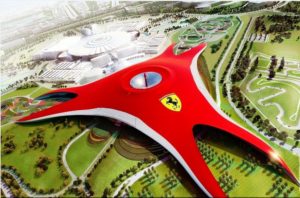| Dhow Creek Cruise | Dubai City Tour |
| Sharjah City Tour | Desert Safari |
| Dhow Creek Cruise | Dubai City Tour |
| Abu Dhabi City Tour | Desert Safari |
| Dhow Creek Cruise | Dubai City Tour |
| Ferrari World | Desert Safari |
Dubai Packages
See Our Cheap Dubai Packages Here
Dubai is the most popular city in the UAE. It is located on the southeast coast of the Persian Gulf and is the capital of the Emirate of Dubai, one of the seven emirates that make up the country. Dubai has emerged as a global city and business hub of the Middle East. The city has become iconic for its skyscrapers and high-rise buildings, in particular the world's tallest building, the Burj Khalifa. Dubai is the 22nd most expensive city in the world and the most expensive city in the Middle East. Dubai's hotel rooms were rated as the second most expensive in the world. Sujaya Holidays will bring you the Cheap Dubai Holiday Package in 3 categories (Budget, Delluxe & Luxury). We strive hard to maintain qualit even for our Budget Packages.
Top Tourist Spots in Dubai
- Burj Khalifa: Dubai's landmark building is the Burj Khalifa, which at 829.8 m is the tallest building in the world. For most visitors a trip to the observation deck on the 124th floor here is a must-do while in the city. The views across the city skyline from this bird's-eye perspective are simply staggering. The slick observation deck experience includes a multi-media presentation on both Dubai and the building of the Burj Khalifa (completed in 2010) before a high-speed elevator whizzes you up to the observation deck for those 360-degree views out across the skyscrapers to the desert on one side and the ocean on the other. Night-time visits are particularly popular with photographers due to Dubai's famous city-lights panoramas. Buy your Burj Khalifa 'At the Top' Entrance Ticket in advance to avoid long line-ups, especially if you are planning to visit on a weekend.
- Dubai Museum: Dubai's excellent museum is housed in the Al-Fahidi Fort, built in 1787 to defend Dubai Creek. The fort's walls are built out of traditional coral-blocks and held together with lime. The upper floor is supported by wooden poles known as "handels", and the ceiling is constructed from palm fronts, mud and plaster. In its history, the fort has served as residence for the ruling family, seat of government, garrison and prison. Restored in 1971 (and again extensively in 1995) it is now the city's premier museum. The entrance has a fascinating exhibition of old maps of the Emirates and Dubai, showing the mammoth expansion that hit the region after the oil boom.The courtyard is home to several traditional boats and a palm-leaf house with an Emirati wind-tower. The right-hand hall features weaponry and the left-hand hall showcases Emirati musical instruments. Below the ground floor are display halls with exhibits and dioramas covering various aspects of traditional Emirati lifestyle (including pearl fishing and Bedouin desert life) as well as artifacts from the 3,000-4,000 year old graves at Al Qusais archaeological site.
- Bastakiya: The Bastakia Quarter was built in the late 19th century to be the home of wealthy Persian merchants who dealt mainly in pearls and textiles, and were lured to Dubai because of the tax-free trading and access to Dubai Creek. Bastakia occupies the eastern portion of Bur Dubai along the creek and the coral and limestone buildings here, many with walls topped with wind-towers, have been excellently preserved. Wind-towers provided the homes here with an early form of air conditioning, with the wind trapped in the towers funnelled down into the houses. Persian merchants likely transplanted this architectural element (common in Iranian coastal houses) from their home country to the Gulf. Lined with distinct Arabian architecture, narrow lanes are highly evocative of a bygone, and much slower, age in Dubai's history. Inside the district you'll find the Majlis Gallery with its collection of traditional Arab ceramics and furniture (housed in a wind-tower) and the XVA Gallery with a contemporary art collection (located in one of the historic buildings).
- Dubai Creek: Dubai Creek separates the city into two towns with Deira to the north and Bur Dubai to the south. The creek has been an influential element in the city's growth, first attracting settlers here to fish and pearl dive. Small villages grew up alongside the creek as far back as 4,000 years ago, while the modern era began in the 1830s when the Bani Yas tribe settled in the area. The Dhow Wharfage is located along Dubai Creek's bank, north of Al-Maktoum Bridge. Still used by small traders from across the Gulf, some of the dhows anchored here are well over 100 years old. You can visit here, watching cargo being loaded and unloaded on and off the dhows. Dhow workers often invite visitors onto the vessels for a tour, where you can gain insight into the life of these traditional sailors. Many of the dhows here travel onwards to Kuwait, Iran, Oman, India, and down to Africa's horn. This tiny remnant of Dubai's traditional economy is still a bustling and fascinating place to wander around. To travel across the creek you can either take a trip on one of the many dhows that have been restored as tourist cruise boats or take an abra (small wooden ferry) between the ferry points on the creek's Bur Dubai and Deira banks.
- Jumeirah Mosque: Jumeirah Mosque is considered by many to be the most beautiful of Dubai's mosques. An exact copy of Cairo's Al-Azhar Mosque that is eight times its size, the Jumeirah Mosque is a fine example of Islamic architecture. This stone structure is built in the medieval Fatimid tradition with two minarets that display the subtle details in the stonework. It is particularly attractive in the evening when lit with floodlights. The Sheikh Mohammed Bin Rashid Centre for Cultural Understanding organises guided tours of the mosque designed to try to foster a better understanding of the Muslim faith. Tours begin at 10am daily, except Fridays.
- Shaikh Zayed Road: Sheikh Zayed Road is the main thoroughfare running through Dubai's modern downtown business district. This wide, eight-lane highway is rimmed with towering glass, chrome and steel highrises along its length. Main attractions are along, or just off, the strip between the roundabout and the first intersection. The Courtyard Gallery (6A Street) has an excellent permanent collection focused on contemporary art from Arab artists. Dubai World Trade Tower (Sheikh Zayed Road) has an observation deck on its top floor that offers visitors panoramic views. The Gold and Diamond Park and Museum (Sheikh Zayed Road) is a one-stop shop for jewellery lovers with 118 manufacturers and 30 retailers all under one roof. The complex's museum presents the history of Arabic jewellery production and also offers short tours of the manufacturing plant.
- Dubai Mall: Dubai Mall is the city's premier mall and provides entry to the Burj Khalifa as well as the Dubai Aquarium. There is also an ice-skating rink, gaming zone and cinema complex if you're looking for more entertainment options. The shopping and eating is endless and there are nearly always special events such as live music and fashion shows within the mall. The most famous of these are the annual Dubai Shopping Festival in January and February and the Dubai Summer Surprises Festival in July and August.
- Burj Al Arab: The Burj Al-Arab is the world's tallest hotel, standing 321 m high, located on its own artificial island on the Dubai coastline. Designed to resemble a billowing dhow sail, the exterior of the Burj Al-Arab is lit up by a choreographed coloured lighting show at night. Decadent in every way possible, it is one of the most expensive hotels in the world with the most luxurious suites costing over $15,000 for one night. For those without unlimited credit, the way to experience the over-the-top opulence is to go for dinner at the underwater Al-Mahara restaurant where floor-to-ceiling glass panels in the dining room walls allow you to view sea life while you eat. Or, book afternoon tea at the Skyview Bar (a minimum spend is required) on the 27th floor with its amazing panoramic views of the city.






